Lunch With... Richard Noble
A chance encounter watching John Cobb inspired a love of speed record breaking. Now he heads the team that’s aiming for 1000mph
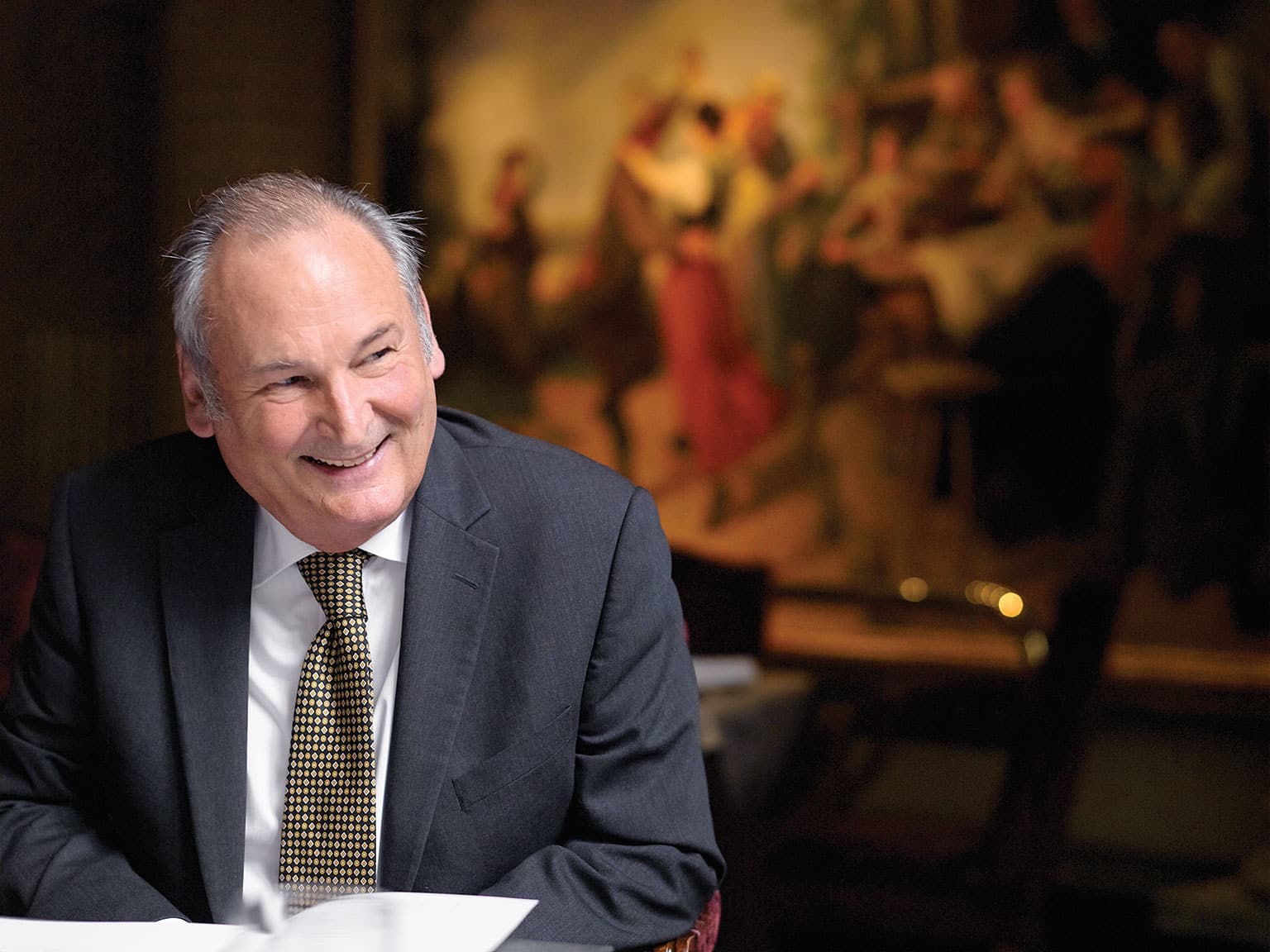
James Mitchell
“For Britain, and for the hell of it.” Just after he had finally become the fastest man on earth, Richard Noble was asked why he’d done it. Why, in pursuing his life’s goal, had he remained single-mindedly determined despite years of frustration, disappointment, sacrifice and penury – and then come within 7mph of almost certain death. His answer perfectly sums up this relentlessly driven man, who comes across as a patriotic mix of Robert Falcon Scott, Frank Whittle and Bulldog Drummond, with perhaps a dash of Gussie Fink-Nottle as well.
We’re lunching in the suitably British setting of the Royal Automobile Club’s Great Gallery in Pall Mall. Richard chooses Devon crab cocktail with Bloody Mary sorbet, and roast halibut. It’s almost exactly 30 years since Thrust 2, his first successful Land Speed Record monster, set a new mark of 633.468mph. That achieved the first goal: to bring the record back to Britain. The second goal, to beat the speed of sound in a car, was thought by many to be an impossibility. But 14 years later, in October 1997, that too was Job Done when Squadron-Leader Andy Green drove Thrust SSC at Mach 1.03, a speed of 763.035mph. And now Richard is immersed, 24 hours a day, seven days a week, in his most ambitious project yet: Bloodhound SSC. This extraordinary vehicle, using both jet and rocket power – plus a current F1 engine, just to drive the fuel pump – will attack the record in a new location in the African desert in 2016. The target? One thousand miles per hour.
Today Formula 1 gets all the glory, all the media coverage. But in the 1930s it was the land speed record that gripped the public’s imagination, and it was much bigger than Grand Prix racing. Names such as Dick Seaman and Raymond Mays were less well-known to the man in the street than those of the record-breakers: Sir Henry Segrave, Sir Malcolm Campbell, George Eyston, John Cobb. Later, in 1952, a six-year-old boy was on holiday with his parents in Scotland when his father stopped their car alongside Loch Ness, where a curious crowd was watching a streamlined silver boat being worked on at the water’s edge. This was the jet-powered hydroplane Crusader, in which John Cobb, already holder of the Land Speed Record at 397mph, was aiming to raise the world’s water speed record to more than 200mph.
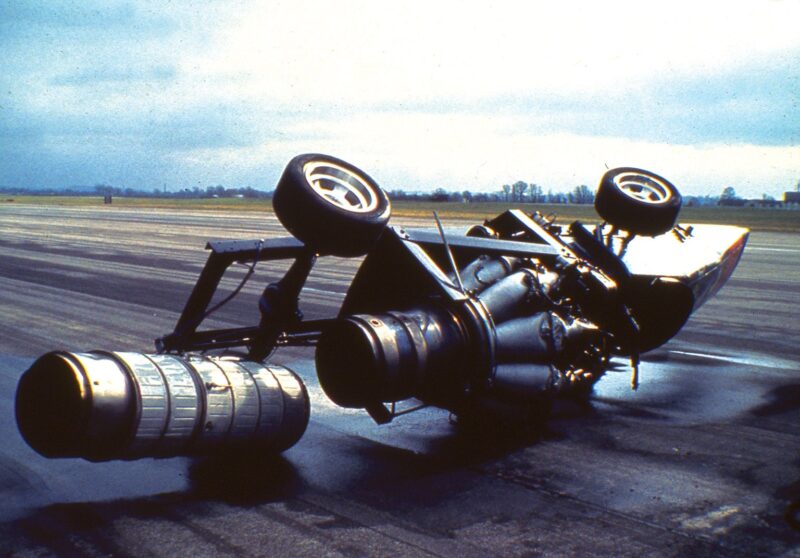
Dramatic outcome of Thrust 1 bearing seizure
Motorsport Images
The six-year-old was Richard Noble, who clearly remembers being “gripped by tremendous excitement” when he saw Crusader. Six days later Cobb died when the hydroplane broke up at well over 200mph. But throughout his childhood Richard remained fascinated by record-breaking, making cardboard models, drawing cars in his school exercise books, reading anything he could get his hands on. From prep school he was clever enough to get into Winchester, but his chief achievement there seems to have been tear-gassing one of the headmaster’s cocktail parties. After school he did an Army Outward Bound course, which he remembers as “seriously tough”, then sold paint for ICI. “It was a dead-end job. There was an insurance company on the other side of the road from our London offices where the staff was evidently equally bored, so with elastic bands we’d fire paper clips at each other across High Holborn. Soon it was outright warfare.”
Then came an overland trip, London to Cape Town, in Richard’s 13-year-old Land Rover. To defray costs he advertised seats at £200 a time, and squashed in five passengers, four of them women. “By the time we’d got as far as Madrid I’d paired off with one of the girls, Sally. By an amazing coincidence her great-uncle had been part of John Cobb’s team during his 1947 record run at Bonneville.” The trip was full of hairy, even life-threatening, incidents, but more than 40 years later Richard and Sally are still married.
“After that I tried to get into the SAS, but after deciding I didn’t really want to kill people I got a job with GKN. And now I got stuck into my dream of building a land speed record car. I sold my Triumph TR6 for £1100 – that was just about all I had – and started on Thrust 1. I didn’t know what the hell I was doing, and in retrospect it was a dreadful car, but it taught me a lot of lessons. I knew it had to have a jet engine, so I managed to get a Rolls-Royce Derwent from a scrapyard for £200 – at 3500lbs thrust, that wasn’t bad horsepower for the money. With help from some friends we welded up a hefty chassis and made a crude open-cockpit body. It was a cross between a go-kart on steroids and a cathedral on wheels. Nothing scientific about any of it, but by March 1977 we were ready for a proper test run at RAF Fairford in Gloucestershire. There was a severe crosswind blowing, but I managed 180mph in one direction, and it felt fantastic. Then coming back I lost control, went sideways, and did a triple airborne roll. Fortunately the big jet engine behind me acted as a sort of roll-over bar, and when it all stopped I wasn’t hurt. We discovered later a wheel bearing had seized.
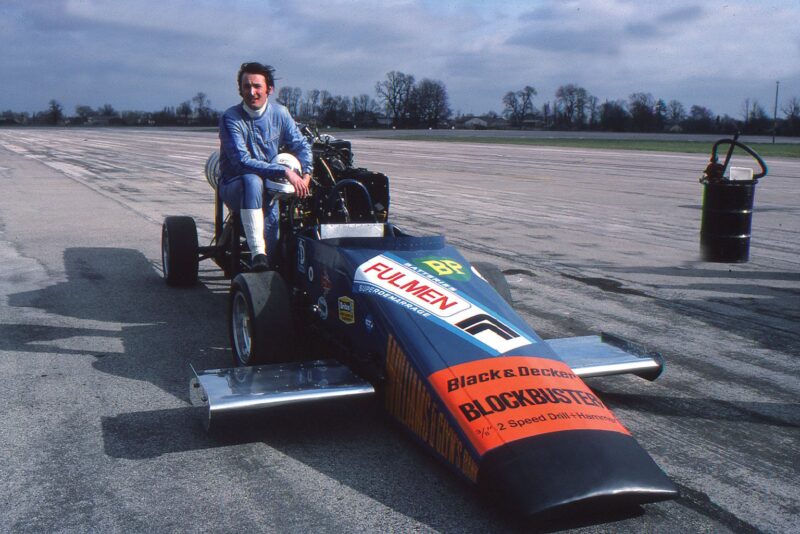
Thrust 1 “like a cathedral on wheels”
“After that crushing disappointment there were three important things to do. The first was to drown our sorrows in the nearest pub. The second was to take the remains of Thrust 1 to the scrapyard. We got £175 for it, which paid a few outstanding bills. The third was to get started on a grown-up programme for Thrust 2. I realised we needed a proper engineering approach, and a proper designer. So we put out a press release: ‘Wanted: 650mph car designer.’ Some quite experienced people applied, but when they found out we were barely getting started and had no money, they all went away. But one application came from a former hovercraft and electric car engineer called John Ackroyd, who’d been working for Audi. Ackers and I got on very well from the start, and soon he was working down on the Isle of Wight, in the kitchen of an empty house, slaving away on his own to design the car. Our budget was non-existent. He didn’t even have a phone, and had to hoard coins to use a public phone box.”
Richard knew that Lightning fighters, which used twin 15,000lbs thrust Rolls-Royce Avon 210s, were being taken out of service and broken up, and he persuaded the Ministry of Defence to sell him an Avon 210 for £2000. Meanwhile he was working indefatigably to publicise the project and bring in sponsors, and little by little some money came in, £1000 here, £1500 there. Then Initial Services, an industrial laundry firm, offered a generous £20,000. Later, when the project was about to run out of money completely, Initial doubled it to £40,000. “God bless them – they saved us.”
But approaches to more mainline engineering and industrial firms, household names whom Richard hoped would want to get behind the record attempt, all produced stony refusals.
“It’s so sad. This is the country that developed Concorde, that had fantastic planes like the Vulcan bomber which could out-manoeuvre any jet fighter above 60,000ft, like the Lightning which went twice the speed of sound, like the Harrier jump jet. These things happened because they were funded by the Government. But if you go to the main board of a big firm and say, ‘Hey, we want to do this, and it will be good for your company and good for the country, but by its very nature we can’t give you a guaranteed business plan’… You get shown the door pretty quick.
“So we were operating on incredibly small sums of money. But if you always think in terms of your available budget you’ll never get there. You’re looking at it from the wrong end. What you must say is, ‘this is what we’re going to do, whatever it takes’. Even when the money is running out, somehow you keep going. And once you’re under way the publicity you can generate is massive. When you find sponsors who understand that, they’ll come on board for the exposure.”
After four years, countless problems and dramas, and the adoption of a more powerful 17,000 lbs Avon 302 engine which set them back a further £4000, the little team arrived on the Bonneville Salt Flats in October 1981. Now running on solid aluminium wheels on the salt surface, at first there were dreadful stability problems, with the car veering uncontrollably off course. It was very demoralising. “Things got very difficult within the team. Some of the chaps believed it was my fault and accused me of being a useless driver. We’d all been working incredibly hard, and I was trying to manage the whole project and drive the car as well, which in retrospect was a big mistake. But once we got the speeds up the stability improved. Gradually we went quicker, and after some runs around the 400mph mark I banged in full after-burner for the first time and got up to a peak of around 500mph. Then it rained, the Flats were flooded, and that was that. We had to go home.
“But before going out to Utah I’d had the idea of spending our last £1000 on insuring against the desert flooding, at 75 to 1. At first the insurers refused to pay up, but after I’d threatened them with all sorts of nasty publicity we got our £75,000. That kept us going for a bit. However, when I told our sponsors that it all had to be postponed until the following year many of them lost interest.

Noble drove not only the Thrust project, but the car too
Thrust Project
“At this point we got the hugely experienced Ken Norris on board. Ken had worked with Donald Campbell on his land and water speed record attempts, and his presence during the actual runs allowed me to concentrate on the driving.” But another huge set-back was in store. During a 300mph test run at Greenham Common, where the runway required rubber tyres, the tyres expanded and fouled the bodywork. Then, with smoke pouring off the wheel arches, the braking parachute collapsed. Using its wheel brakes Thrust 2 left skid marks for three-quarters of a mile before going off the end of the runway and bounding over rough grass. Not only was the front of the car wrecked: the engine suffered severe FOD – foreign object damage – by ingesting stones and debris which twisted the vulnerable compressor section blades. The doughty little team had the car straightened out in 12 weeks, but Rolls-Royce quoted £80,000 for engine repairs, which was off the planet. So the maintenance staff at RAF Binbrook worked nights, for nothing, to rebuild the engine “and the Queen paid for the parts”. The project was on again.
But the roller-coaster continued. Back at Bonneville in September 1982 heavy rain flooded the Flats. Undaunted, in six days the Thrust team had relocated to Nevada and the Black Rock Desert. Local permissions were secured and 11 miles of flat course painstakingly cleaned of pebbles and other potential FOD material. Over several runs between October and November Thrust 2’s speed gradually climbed from 463mph to 590mph, with a peak of 615mph. But the existing record, the American Gary Gabelich’s 1970 mark of 622mph with his rocket-powered Blue Flame, remained unbeaten. Then it started to snow. Once again it was time to go home. There followed another year of rebuilding the car, trying to keep existing sponsors on board, and hunting for new ones. In September 1983 they were back at Black Rock. “I knew this would be our last shot, and we were having some engine problems. So I sent a pleading fax to the Rolls-Royce chairman, Sir William Duncan. He was none too pleased – we were after all talking about an engine I’d bought more or less as scrap for £4000 – but he sent one of his technical experts over to look at it. This lovely chap, George, discovered that we had the reheat linkage wrongly connected, so we weren’t bringing in the final 25 per cent of the afterburner. Suddenly we had a hell of a lot more thrust available. We did more and more runs, making adjustments as we went, and now we’d got it very stable. I did something like 11 two-way runs in the sub-sonic range and I could place it within a lateral accuracy of two inches.
It was like driving a taxi. But to get clear of Gabelich’s record we still needed more speed – which meant we had to reduce Thrust 2’s drag.
“We’d done some good trans-sonic wind-tunnel testing at British Aerospace with a small model, which gave us plenty of confidence. But in those days we couldn’t model the car using CFD [computational fluid dynamics] and we didn’t appreciate that, as we went further and further into the trans-sonic range, what we were doing was frankly very dangerous. Once you start getting to Mach numbers of 0.9 you’re into different regimes altogether. You’ve got huge chunks of air passing over the car, some of it subsonic, some of it supersonic. Ackers raised the ride height at the front by a tiny amount, 0.017 of a degree. That was enough to reduce the downforce dramatically. And finally, on October 4, we did it: 624.241mph in one direction, 642.971 in the other, a two-way average of 633.468. We’d done it. We had the world Land Speed Record.
“Our peak speed going through the measured mile had been just over 650mph. It was only later, when we went through all the data and computed the effect of the reduced front downforce, that we realised that at 657mph the front of Thrust 2 would have left the ground, the sub-sonic and supersonic air would have got underneath it, and it would have become a ground-to-air missile. So we had been perhaps 7mph away from total disaster.
“Out there in the Black Rock Desert, once we knew we had the record, our little team was overtaken by total euphoria. After nine years of ceaseless graft, of incredible ups and downs, the record was ours. We were swamped by massive joy and relief, by cheers and tears. But strangely, within perhaps half an hour, all that went away, and then we just felt bloody miserable. We were a terrific little team of people, we’d been thrown together, all working night and day towards this goal. Now there was no reason to stay together any more. When we got home there were lots of parties and awards and plaudits for us, but the best thing was to recognise it was all over, and move on.”
In Richard’s case moving on meant starting a light aircraft company. About 40 of his innovative ARV Super2s were built, with a two-stroke engine designed and built by gearbox guru Mike Hewland, and Richard still owns aircraft no12. Later came a project initially involving Ted Toleman, Don Shead and Adrian Hamilton to cross the Atlantic non-stop in a boat powered by a Rolls-Royce RB211 jet engine geared to propellors, but that failed to generate the necessary backing. Meanwhile Richard couldn’t get out of his mind the idea of a car that could exceed Mach 1.
“In 1992 I met Ron Ayers. He was head of Operations Research at BAC’s Guided Weapons Division and chief aerodynamicist on the Bloodhound 2 anti-aircraft missile, and he is the cleverest person I know. He had some strong views on why land speed record cars failed to achieve the theoretical maximum that their power outputs indicated they should reach. Together with Glynne Bowsher, who’d been involved on Thrust 2, that was the start of a relationship which grew into the Supersonic Car programme, Thrust SSC.”
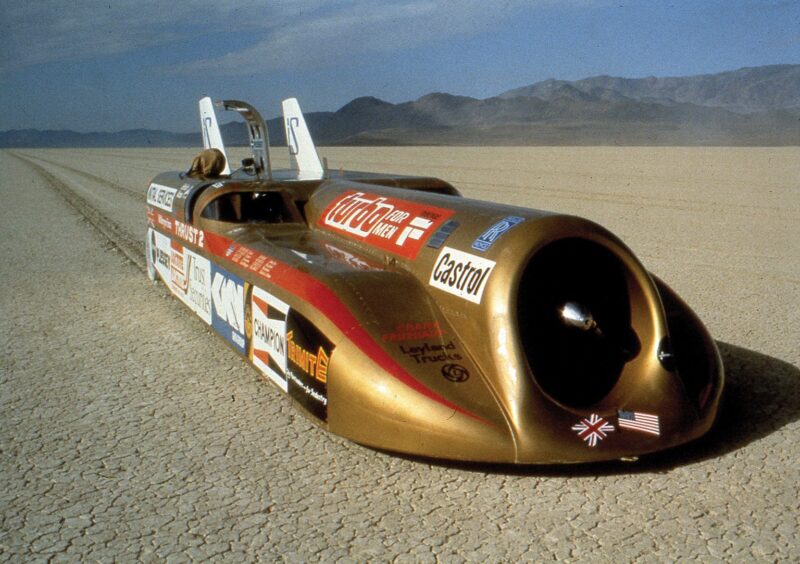
Thrust 2 with central Avon jet and offset cockpit
Thrust Project
To achieve supersonic speeds much more power would be needed. Richard, wheeling and dealing as always, found that the Ministry of Defence were selling off redundant Rolls-Royce Spey 205 jet engines as fitted to the Phantom F4 fighter. He bought two for £5000, to give a combined thrust of 44,000lbs. After several early proposals, Ron and Glynne came up with a layout putting the two massive engines side by side, with the driver centrally between them “for the best seat-of-the-pants feel”. A major innovation was rear-wheel steering: a wide fixed front track, and twin rear wheels close together and staggered one behind the other to change the car’s direction. With fuel on board, the whole car, 54 feet long, would weigh 10.5 tons. Compared to Thrust 2, the whole approach was massively more scientific. By now CFD was available. Swansea University came on board to help with this, as well as Cray Research, which donated time on one of its super-computers which was capable of five billion calculations a second. At the same time a rocket-powered model was built, covered with pressure sensors and fired down a rail, going from zero to 850mph in 0.8sec, an acceleration of 50g.
To everyone’s relief the real-life results from the model matched almost exactly the theoretical CFD results. That gave the team the confidence to go ahead and build the car.
Added pressure came from the open secret that McLaren was also planning to build a car to attack the Land Speed Record, and beat the speed of sound. Its carbon-fibre car, the McLaren Maverick, had its front wheels very close together to give an almost three-wheeled layout. “We knew they had access to budgets and sponsors we could only dream about, and excellent contacts with Rolls-Royce for their engines and British Aerospace. One rumour said that, although Ayrton Senna had by then left McLaren for Williams, he wanted to drive the car. Anyway, the McLaren stories meant we had no time to lose – although in the end the Maverick was never built.
“I knew it was wrong that I’d been both project leader and driver on Thrust 2. So at the press launch I let it be known that we were looking for a driver, and 30 people got in touch. Through various tests at the Centre for Human Sciences at Farnborough we whittled them down to five, all of whom were fliers of once sort or another: three Tornado pilots and two civil airline pilots.” There followed a very complex selection process involving, among other things, driving a rally car on the loose with Russell Brookes in the passenger seat, and tests to identify teamwork abilities under pressure. In January 1995 Richard telephoned Squadron Leader Andy Green to tell him he was their man. Typically, he had to phone him in Switzerland, because this all-action fellow was busy doing the Cresta Run.
Andy told me the full, almost unbelievable story of Thrust SSC when I had Lunch With…. him for Motor Sport’s November 2007 issue. The SSC project went through just as many dramas and setbacks, and financial ups and downs, as Thrust 2 had done. Once again – and with a far more complex, far more costly programme this time – sponsors were hard to find and money was incredibly tight. Vital support came from members of the public who joined the Mach 1 Club and bought merchandise, anything from T-shirts to life-expired bits of the car, and the project’s website grew to one of the largest on the internet, and generated extraordinary response.
“Safety was always a prime consideration. We agreed that if we felt we couldn’t go supersonic with Andy in safety we would abort the project. An ejector seat was out of the question – obviously he couldn’t eject at 800mph at ground level – so the cockpit was surrounded by a welded steel box and a two-inch thick firewall. There were also halon and water extinguishers and a 30-minute supply of compressed air. Even so, these might not have been enough to save him in a crash at that sort of speed, so we had to place the emphasis on accident prevention, with fail-safe logic circuitry to ensure that no system failure could result in the car becoming airborne, and to shut-down systems in case of engine problems. By the end Thrust SSC had completed 66 runs in safety.”
Early tests took place on the Al Jafr desert in Jordan in 1996, but only resulted in a best speed of 340mph. The following year a return to Al Jafr produced 540mph, but also a suspension failure that could have cost Andy Green’s life. Meanwhile Andy was having serious doubts about being able to keep the car stable, and privately had to develop his own technique of feeding in steering inputs in advance of what he thought the car was going to do. As he said later, “I eventually found a driving technique that worked, but I never really enjoyed driving the car. It was too much like hard work.” Richard’s summation is a little different. “Andy did bloody well. It wasn’t a comfortable car to drive at subsonic speeds. The rear-wheel steer made it frightfully difficult. The funny thing was, once it got well up into the really high Mach numbers and went supersonic, it was an absolute baby.” Andy’s version is more graphic: he described the delicacy it required as “trying to balance the point of a pencil on the end of your finger” and “taking all the hairiest bits of a three-hour sortie in a Tornado jet fighter and packing them all into two minutes.”
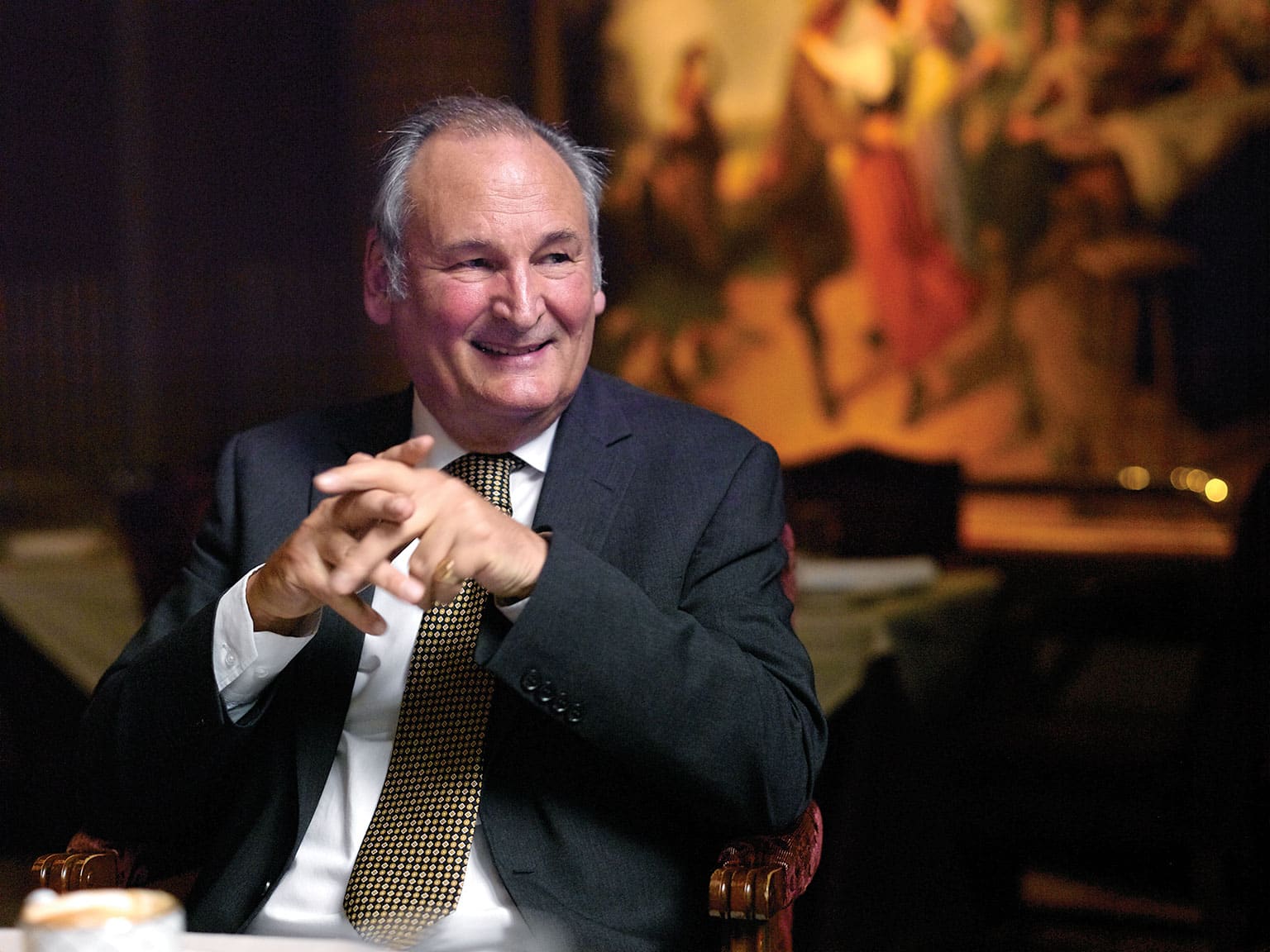
Despite all the money problems, Richard’s determination got the team to the Black Rock Desert in September 1997. The 13-mile stretch of desert was cleaned and prepared and the runs began, each with a carefully prepared profile. Before long Andy had taken the car up to 719mph. Then the braking parachute tore off, which meant Andy had to overshoot his stopping point by a mile and a half and the crew couldn’t turn the car round for the return run within the 60 minutes specified by the rules. On September 25 he did a mean in both directions of 714.144mph, more than 80mph faster than Richard’s record. However, when Andy inspected the tracks he could see that there was one point where one of the front wheels was leaving no mark in the desert surface – the car was becoming airborne. Calculations showed that Thrust SSC’s static weight on the front wheels of 6.5 tons was being reduced to a mere 200 kilos. Adjustments to increase the downforce made the car plough into the surface and become dramatically unstable. Finally – and not without much friction within the technical team – the very clever active suspension system, which Jerry Bliss had designed to optimise the ride height and control the downforce front and rear, was disconnected.
On successive runs over the next few days the speeds climbed. Finally, on October 15, Thrust SSC tore silently through the mile, followed by the double bang of the sonic boom and then a thunderous blast of sound. The car was turned around within the 60-minute limit, back it came, there were the booms again, and finally the result came through. For the entire team, it was an incredible achievement: 763.035mph, Mach 1.03. After five years of ceaseless effort, the job was done.
“Once again we went through the euphoria, and then the feeling of disappointment, of emptiness almost, because it was all over. We were all absolutely exhausted, and it took most of us two years to recover. In 2006 there was the JCB Dieselmax project, which did 350mph using two JCB diesel engines: Andy was the driver, and I was just a consultant on that project. But at the back of my mind I knew there was unfinished business. I heard that the American adventurer and record-breaker Steve Fossett was after our record, using an update of Craig Breedlove’s old car Spirit of America. This was a real threat: he had the money, he had the motivation, he had the ability. So Andy and I met in a pub and decided we had three options. One was to do nothing: no one could ever take away that we were the first to break the sound barrier, and we could rest on our laurels. The second was to wait and see what the Americans would do and then react – by which time it would probably be five years too late. Or we could do something now: build the greatest car we could ever do, the ultimate car, and go for 1000mph. And that was the beginning of Bloodhound SSC.
“In fact Steve Fossett tragically died in 2007 when his Bellanca Super Decathlon plane crashed high in the Sierra Nevada. His remains weren’t found for more than a year. By then we’d already met with Ron Ayers and told him we wanted a car that could do Mach 1.5. That’s about 1200mph, and he was a bit horrified by the idea. So we did a bit of horse-trading and in the end he agreed that Mach 1.4, or 1000mph, could maybe be done. But it would need an awful lot of power. Drag goes up as the cube of the speed, so if you want to go twice as fast you need eight times the power for a given weight. And the supersonic shock waves absorb power: we’d calculated Thrust SSC would do 850mph, but it went to 770mph and wouldn’t go any faster.
“This is when we came up with the concept of using both a jet engine and rocket power, one sitting on top of the other, with the rocket being brought in as Bloodhound reaches the higher speed ranges. With two jet engines the drag from the air intakes would be too great, but a rocket doesn’t need an air intake. The jet we chose is the EJ200 from the Eurojet fighter, a fantastic thing, like a piece of jewellery. It produces 20,000lbs of thrust. The rocket we have to build ourselves. With a solid fuel rocket, if you have a problem you can’t switch it off. On the other hand, If you’re using kerosene and liquid oxygen and you need to shut down, you can get an enormous explosion. So Daniel Jubb, our rocket guru, came up with a hybrid rocket using solid fuel and a liquid oxydiser, so if something goes wrong you can shut down the oxydiser and the fire goes out, it doesn’t explode. We still have to do the 60-minute turnround, which with Bloodhound means taking out and replacing the whole rocket motor and loading a ton of HTPB. But we’ve worked it out, and we can do it.
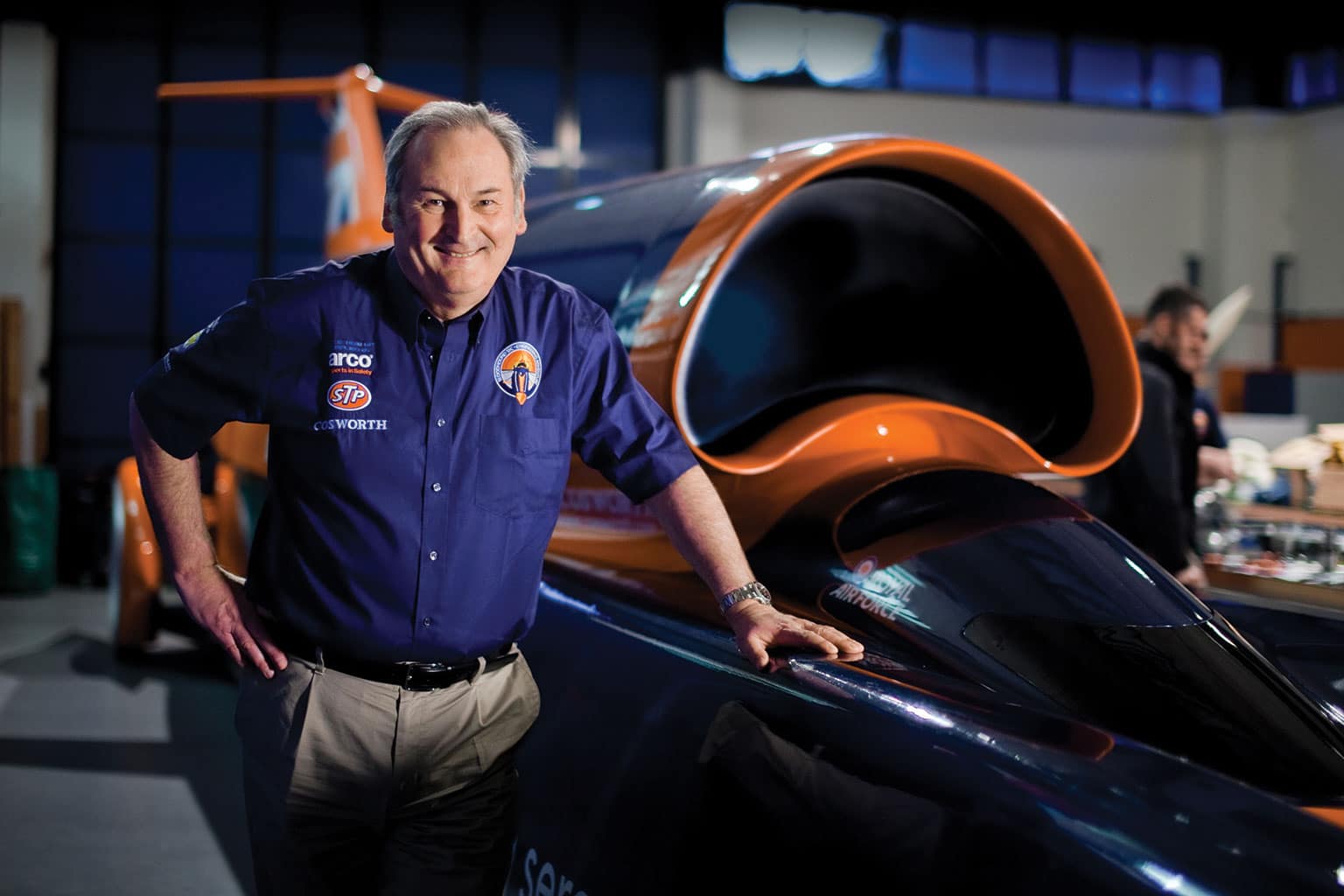
“The whole car will have effectively 133,000 horsepower, to move 7.5 tons. Torsional rigidity is crucial, but with a lot of it made of carbon fibre, it’ll be a lot lighter than Thrust SSC. And Daniel reckons the noise of all that lot will be about the same as 25 jumbo jets taking off. Plus we have a third engine, from a current Formula 1 car. This is 750bhp-worth of Cosworth CAV8, and it’s needed just to drive the fuel system pumping the oxydiser to the rocket, delivering almost a ton of HTPB [hydroxyl-terminated polybutadiene] in 20 seconds.”
At top speed the forged aluminium tyreless wheels, three feet in diameter, will be rotating at 10,200rpm. A 12-mile track is needed: 5.5 miles for Bloodhound to accelerate, using first the jet and then the rocket, to get up to 1000mph. Then comes the measured mile, which will take 3.6sec. Then it needs 5.5 miles to slow down, with a peak deceleration of 3G. First the air brakes will fold out from the car’s sides. When the speed has come down through the transonic region to 670mph a parachute can be deployed, with a second parachute at 400mph. Finally at 200mph the wheel brakes can be used to stop the car in the right spot for the turnaround procedure.
“We knew that we couldn’t go back to Black Rock for this attempt. Due to global warming they’ve been having a lot of rain there. In the end we found an incredibly flat piece of desert land in the Northern Cape of South Africa at Hakskeen Pan. There is extremely high unemployment there, so the local government was happy to help out preparing the surface. They already have 300 people working on it full-time, picking up stones. They’re wonderful people, they’ve really got involved. As far as they’re concerned it’s their car.
“The real difficulty with all this stuff is that there’s no precedent. Technologically we’re going into the unknown. Actually it causes a lot of distress in the aerospace world where they have huge teams of people, big test programmes, big budgets. We’re just 60 people in total, we’re building a car that will do Mach 1.4, and we’re determined to succeed. Having said that, we’re all totally committed to a culture of absolute safety. If I think we can’t guarantee that, I’ll abort the project. Our sponsors have to know that their investment is in safe hands.
“In the end, it cost £2.5 million to break the speed of sound with Thrust SSC. The whole Bloodhound project is in a different league. It’s going to cost £42 million. So far we’ve raised about a third of that, and we’re on course to run in 2015. Part of the difference is that we can now analyse and model everything in immense detail, because of how computer science has progressed since 1997. And with Bloodhound we’ve got an enormous additional plus, which is its power as an educational tool.”
This came out of a meeting with Lord Drayson, Le Mans racer and electric speed record breaker, who held defence and science posts in the last Labour government. “Paul said, ‘We have a huge shortage of young engineers and scientists in this country now. Back when Britain was producing all those fantastic aeroplanes there was something to capture the imaginations of a whole generation of school kids. Now all they’re interested in is getting on X-Factor. We’d like you to fire up today’s kids to make them into tomorrow’s engineers.’
“So we got an education team together, and talked to teachers. What they wanted was not posters and paperwork but live data which the kids could access. So we’re giving them on-line learning, drawings of the car, masses of real data, and our website is being followed by kids all round the world. It’s good for sponsors’ corporate and social responsibility, too. And when we do the actual runs the kids will be able to follow live data from the car then, too.
“We’ve had response so far from 5000 schools in Britain. Things like a letter from a nine-year-old girl saying she’d never understood what maths and physics were about, but now she wanted to be an engineer. What these kids are doing is phenomenal. A school in Walsall built a rocket-powered model, and set a new world’s playground speed record at 88mph. Then Heathland School in Hounslow raised it massively. Would you believe 204mph? That’s across the school playground, with a car a foot long that they’d designed and built themselves, all independently timed by people from the Guinness Book of Records. They had to do the one-hour turnaround and get a mean of two directions, too. You can watch it on YouTube. And now the South African kids want to have a go, too.”
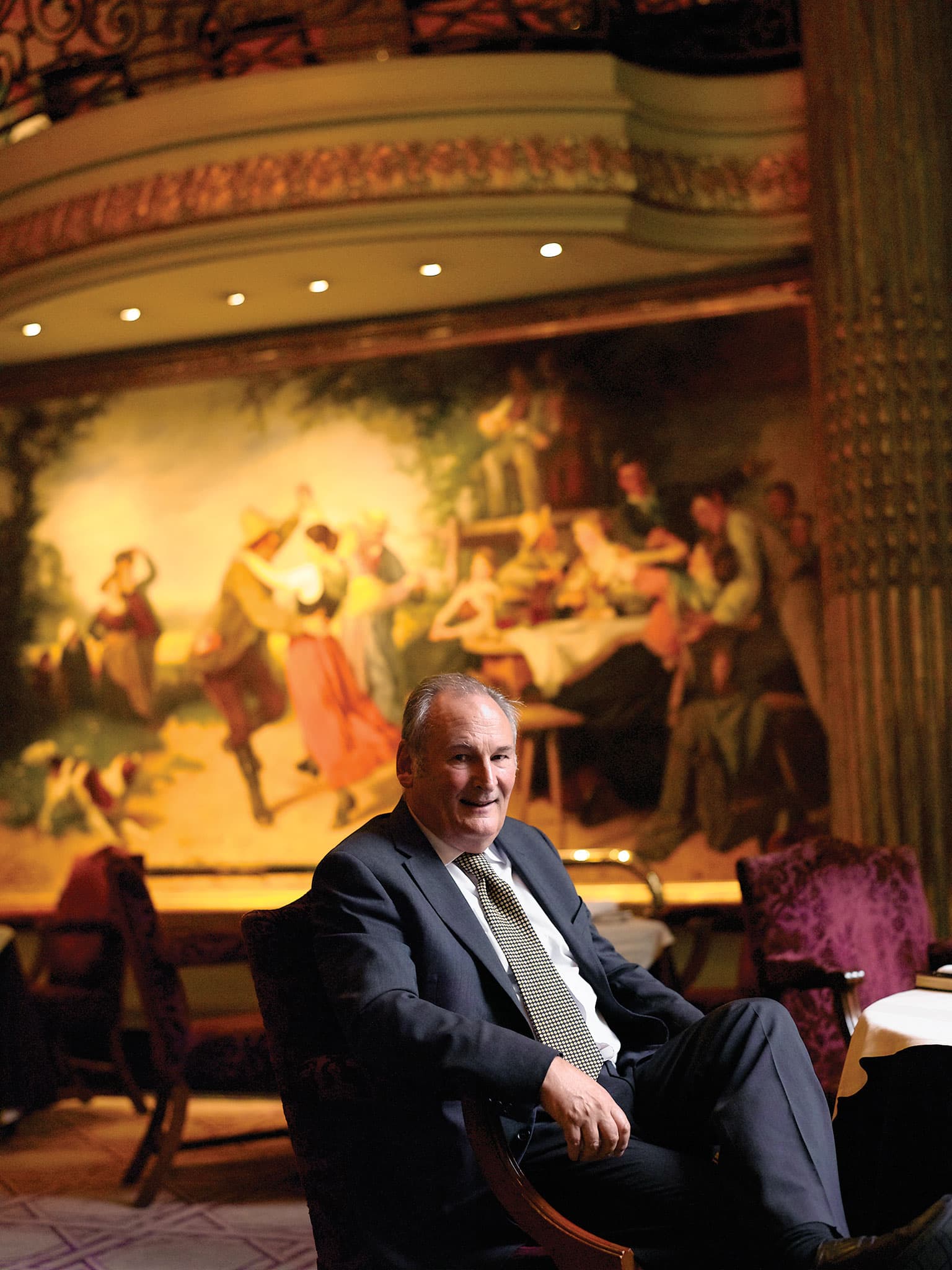
The project’s educational potential has become so crucial that, for Richard, inspiring a new generation of engineers is Bloodhound’s prime objective. Objective Two is to provide an innovative R&D programme to which students will have access. Taking a new land speed record for Britain at over 1000mph is now only Objective Three, although of course all are inextricably linked.
“Meanwhile the website support is immense. We reckon it’s been looked at by people in every country in the world apart from North Korea and the Vatican City, and we’ve been raising up to £30,000 a month from ordinary people in donations and merchandise sales. As it all gathers momentum, there are some big potential sponsors out there who are going to have to decide. Do they do something conventional like Formula 1, perhaps putting stickers on a mid-grid team that rarely makes it onto the TV coverage? Or do they do something really brave, something that may perhaps be seen as higher risk, and come in with us on Bloodhound?”
Down at the project’s premises at Avonmouth, Bloodhound SSC is coming together. Meanwhile, with crusading zeal, Richard is pounding on boardroom doors up and down the country to persuade British companies that this is a once-in-a-lifetime opportunity to attach their name to perhaps one of the last great human adventures of our age. Already the list of firms that have helped in cash or in kind number over 180.
With maybe £25 million left to find, he still has a lot of work to do. But Richard Noble is unshakeably convinced that he will succeed, just as he is unshakeably convinced that Bloodhound SSC will achieve 1000mph at Hakskeen Pan. It is an extraordinary project: brave, technologically innovative, and involving almost superhuman dedication and endeavour from a small, tightly-motivated team of clever people. Bloodhound SSC merits our help, and it absolutely deserves to succeed. For Britain, and for the hell of it.
